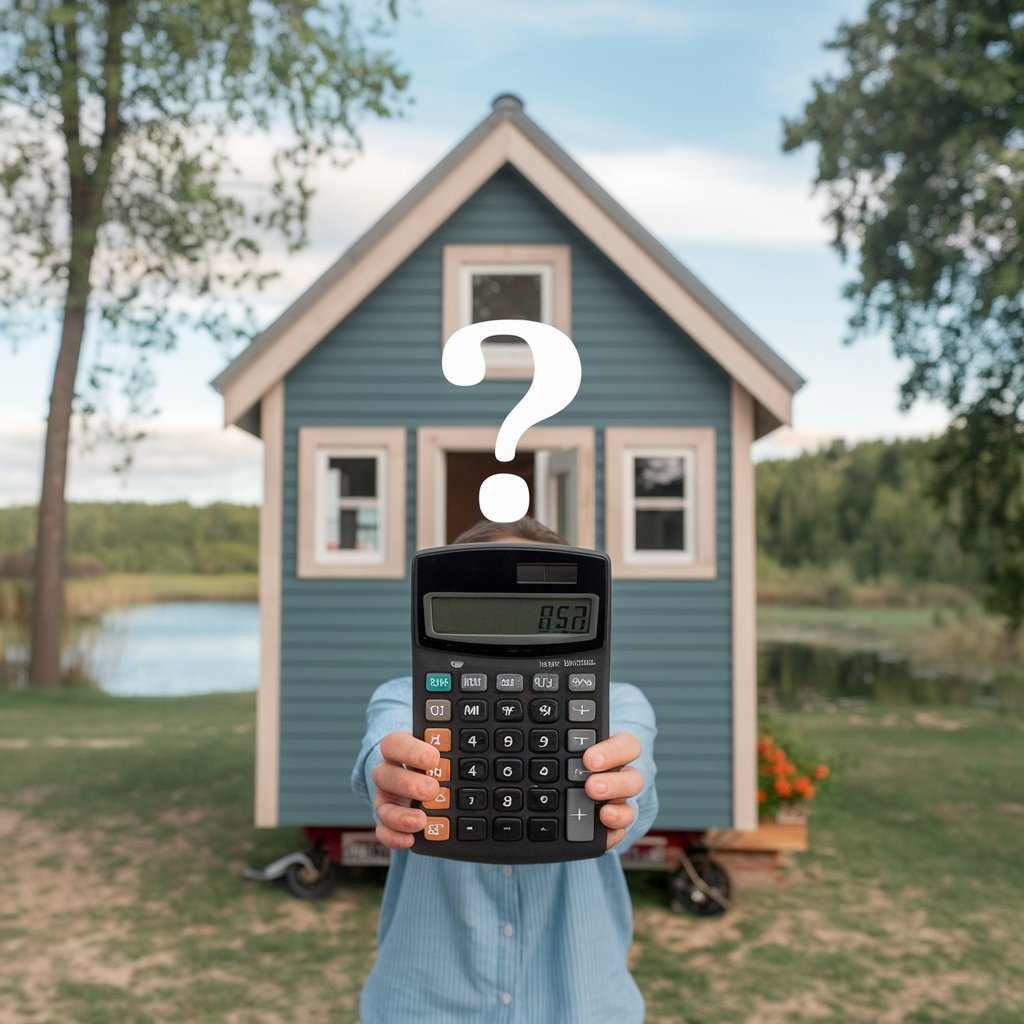The winter tiny house buying advantages extend far beyond simple seasonal pricing, offering savvy purchasers a unique opportunity to secure exceptional value while capitalizing on energy efficiency benefits that become immediately apparent during the coldest months of the year. Recent market analysis reveals that tiny house buyers who purchase during winter months can save 10-15% on average purchase prices while gaining access to properties specifically designed and tested for cold weather performance [1]. This strategic timing advantage, combined with the inherent energy efficiency of well-designed tiny houses, creates a compelling case for winter purchases that smart buyers are increasingly recognizing and leveraging.
Table of Contents
Many prospective tiny house buyers mistakenly assume that winter represents the worst time to purchase these compact homes, citing concerns about heating costs, comfort limitations, and seasonal accessibility challenges that seem to make cold weather purchases impractical or risky. However, this widespread misconception creates significant opportunities for informed buyers who understand that winter tiny house buying advantages actually multiply during the coldest months, when energy efficiency becomes most critical and market dynamics favor serious purchasers over casual browsers [2]. The reality is that tiny houses designed for year-round living excel in winter conditions, often outperforming traditional homes in both comfort and cost-effectiveness when properly constructed and equipped.
This comprehensive guide reveals the substantial winter tiny house buying advantages that experienced purchasers use to secure better deals, ensure superior cold weather performance, and maximize their investment returns through strategic seasonal timing. From understanding energy efficiency benefits that can reduce heating costs by up to 70% compared to traditional homes, to leveraging off-season market conditions that create negotiation opportunities unavailable during peak buying seasons, winter purchases offer multiple layers of value that extend well beyond the initial transaction [3]. Whether you’re a first-time tiny house buyer or an experienced investor looking to expand your portfolio, understanding these winter advantages will help you make informed decisions that provide both immediate and long-term benefits.
Energy Efficiency and Heating Advantages
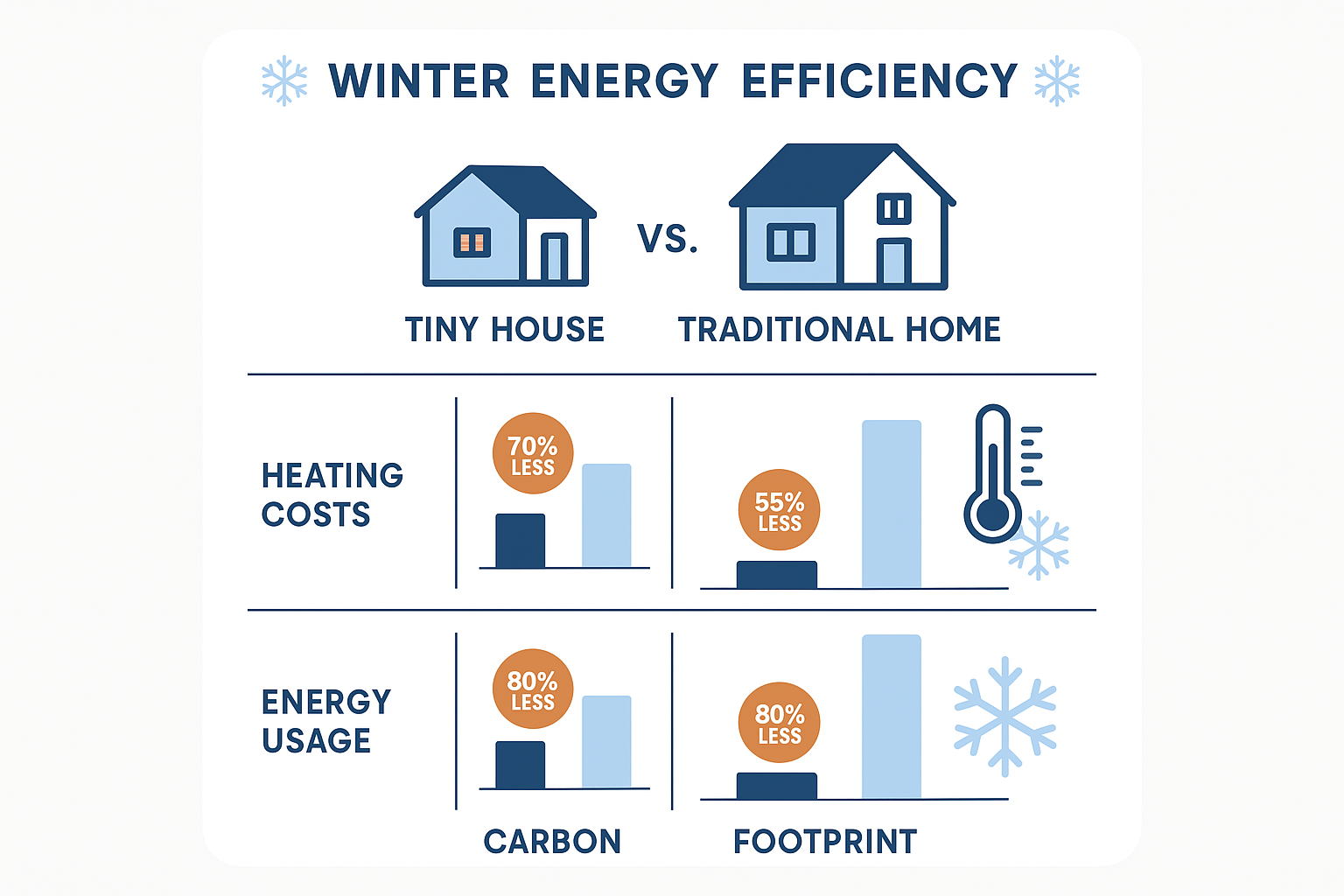
Comparison of winter heating costs and energy usage between tiny houses and traditional homes
The superior energy efficiency of tiny houses becomes most apparent during winter months, when heating costs represent the largest component of utility expenses and the compact design principles that define these homes deliver their greatest financial benefits. Tiny houses typically require 70% less energy for heating compared to traditional homes of similar quality, with average winter heating costs ranging from 50−150permonthversus50-150 per month versus 50−150permonthversus200-500 for conventional houses in similar climates [4]. This dramatic efficiency advantage stems from the reduced square footage that requires heating, superior insulation-to-space ratios, and modern heating systems specifically designed for small spaces that can maintain comfortable temperatures with minimal energy consumption.
The physics of heating small spaces work strongly in favor of tiny house owners during winter months, as the reduced volume of air that needs to be warmed allows heating systems to reach and maintain target temperatures much more quickly and efficiently than in larger homes. Modern tiny houses incorporate advanced insulation techniques, including spray foam insulation, double or triple-pane windows, and thermal bridging prevention that creates highly efficient thermal envelopes capable of retaining heat even in extreme cold conditions [5]. These design features, combined with strategic placement of heating sources and careful attention to air sealing, enable tiny houses to maintain comfortable interior temperatures with heating systems that consume a fraction of the energy required by traditional homes.
The heating system options available for tiny houses have evolved significantly in recent years, with ductless mini-split heat pumps emerging as the most popular and efficient choice for year-round climate control. These systems can achieve heating efficiencies of 300% or higher, meaning they produce three units of heat for every unit of electricity consumed, making them exceptionally cost-effective for winter heating [6]. Alternative heating options, including high-efficiency wood stoves, propane heaters, and radiant floor heating systems, provide additional flexibility for tiny house owners who want to optimize their heating costs based on local fuel prices and personal preferences.
The immediate feedback loop between energy consumption and comfort in tiny houses helps owners optimize their heating efficiency in ways that are impossible in larger homes, where inefficiencies can go unnoticed for months or years. Tiny house owners quickly learn which heating strategies work best for their specific climate and usage patterns, often developing sophisticated approaches to thermal management that can reduce heating costs even further below the already impressive baseline efficiency levels [7]. This hands-on understanding of energy efficiency principles often leads to heating cost reductions that exceed initial projections, making winter tiny house ownership even more economical than anticipated.
Off-Season Market Benefits and Pricing
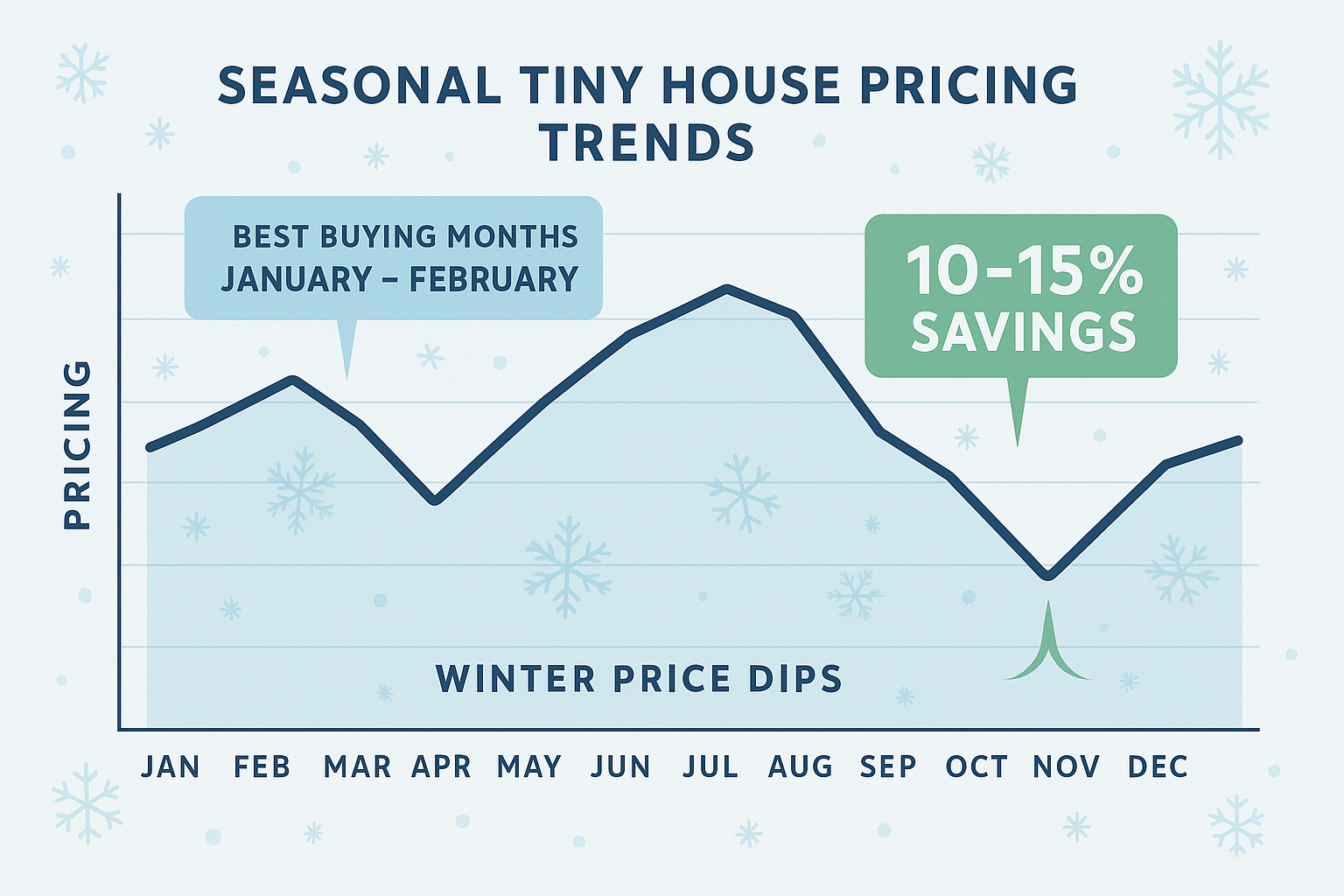
Annual pricing trends showing winter price dips and optimal buying periods
The winter tiny house market presents unique opportunities for buyers who understand seasonal pricing patterns and can capitalize on reduced competition from other purchasers who postpone their buying decisions until spring and summer months. Market data consistently shows that tiny house prices drop 10-15% during winter months, with the most significant savings occurring in January and February when inventory levels are highest and buyer activity reaches annual lows [8]. This seasonal pricing advantage reflects both reduced demand from buyers who prefer to shop during warmer months and increased motivation from sellers who want to complete transactions before year-end for tax and financial planning purposes.
Builder incentives and promotional pricing become most aggressive during winter months, as manufacturers and custom builders seek to maintain cash flow and production schedules during traditionally slower periods. Many established tiny house builders offer winter-specific promotions, including reduced pricing, upgraded features at no additional cost, and flexible delivery schedules that can save buyers thousands of dollars compared to peak season purchases [9]. These incentives often include valuable additions such as upgraded insulation packages, premium heating systems, or enhanced weatherproofing features that provide immediate value for winter occupancy while reducing long-term operating costs.
The reduced competition from other buyers during winter months creates negotiation advantages that extend beyond simple pricing considerations, enabling serious purchasers to secure better terms, more flexible closing schedules, and additional concessions that may be unavailable during peak buying seasons. Sellers who list their tiny houses during winter months are typically more motivated to complete transactions quickly, often accepting lower offers or agreeing to favorable terms that reflect their desire to avoid carrying properties through the winter months [10]. This seller motivation, combined with reduced buyer competition, creates ideal conditions for negotiating comprehensive deals that address multiple aspects of the purchase beyond just the sale price.
The winter buying season also provides access to inventory that may not be available during peak months, as some sellers specifically time their listings to avoid the crowded spring and summer markets where their properties might get lost among numerous competing listings. Unique or custom-built tiny houses often appear on the market during winter months, when sellers believe they can attract more focused attention from serious buyers who are actively shopping rather than casually browsing [11]. This inventory advantage can be particularly valuable for buyers seeking specific features, layouts, or construction quality levels that may be difficult to find during more competitive buying seasons.
Winter-Ready Features and Construction Benefits
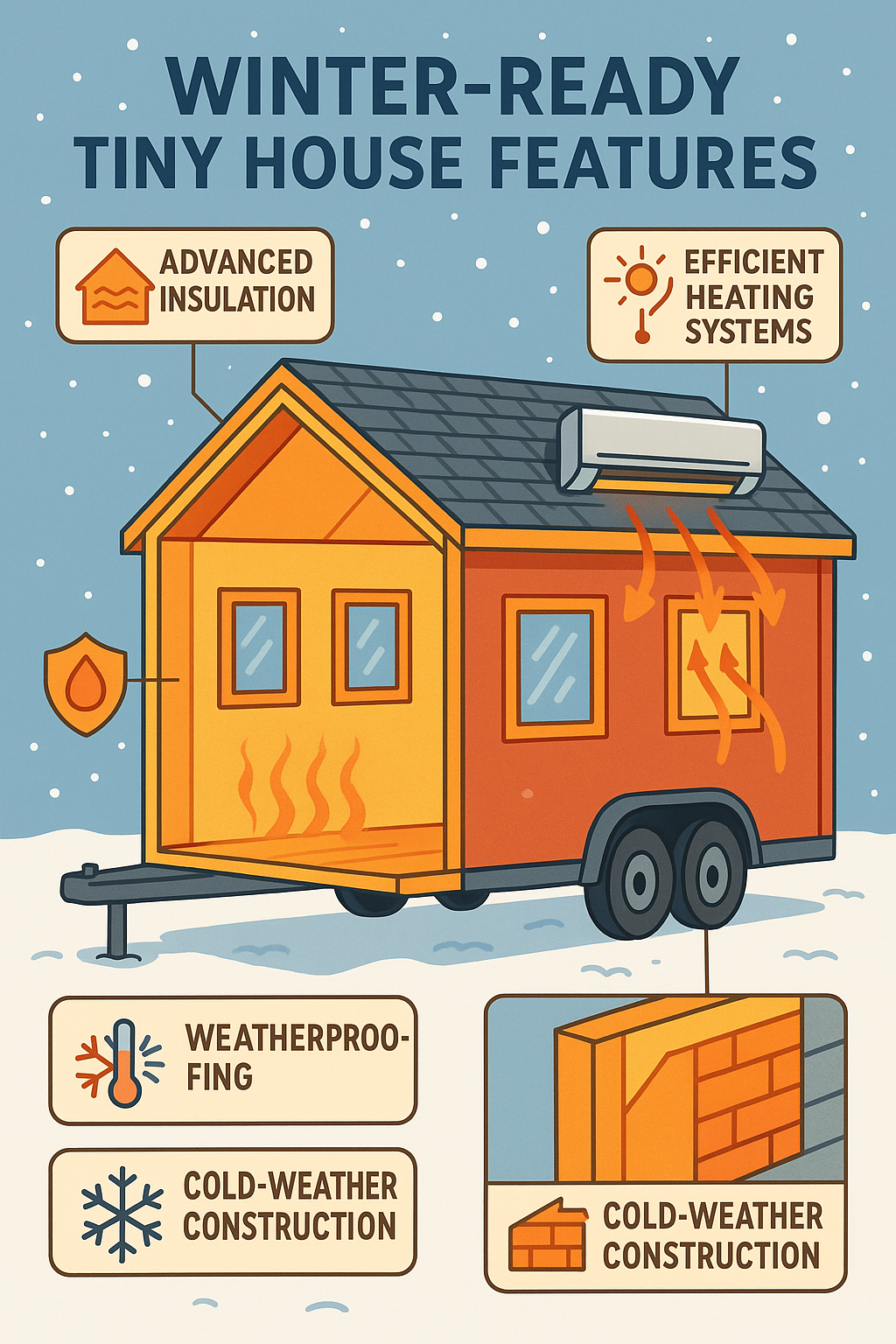
Infographic showing essential winter features including insulation, heating systems, and weatherproofing
Tiny houses designed for year-round living incorporate specialized construction features and systems that provide superior performance during winter months, making cold weather purchases an ideal time to evaluate and appreciate these critical design elements. Advanced insulation systems, including closed-cell spray foam, rigid foam board, and high-performance fiberglass batts, create thermal envelopes that can maintain comfortable interior temperatures even when exterior temperatures drop well below freezing [12]. These insulation systems, combined with careful attention to thermal bridging and air sealing, enable tiny houses to achieve R-values that often exceed those found in traditional construction while using significantly less material and space.
The compact size of tiny houses allows for more intensive insulation approaches that would be prohibitively expensive in larger homes, including continuous insulation systems that eliminate thermal bridges and advanced vapor barrier techniques that prevent moisture problems common in cold climates. Many winter-ready tiny houses incorporate insulation levels that exceed building code requirements by 50% or more, with wall assemblies achieving R-20 to R-30 values and roof systems reaching R-40 to R-50 performance levels [13]. These superior insulation levels, combined with high-performance windows and doors, create living environments that remain comfortable and energy-efficient even in extreme cold conditions.
Heating system integration in tiny houses benefits from the compact space requirements and simplified distribution needs that make high-efficiency systems both practical and cost-effective. Ductless mini-split systems, which have become the gold standard for tiny house heating and cooling, can maintain precise temperature control throughout the entire living space using a single indoor unit, eliminating the ductwork losses and zone control challenges that plague larger homes [14]. These systems also provide efficient cooling during summer months, making them year-round solutions that justify their higher initial costs through superior performance and energy savings.
The structural design of tiny houses built for cold climates incorporates features specifically intended to handle snow loads, wind stresses, and thermal expansion challenges that can affect mobile structures during winter months. Reinforced roof systems, upgraded trailer frames, and enhanced connection details ensure that tiny houses can safely handle the additional stresses imposed by winter weather conditions while maintaining structural integrity and occupant safety [15]. These construction upgrades, while adding to initial costs, provide long-term value through improved durability and reduced maintenance requirements that become particularly important for year-round occupancy.
Seasonal Lifestyle and Comfort Advantages
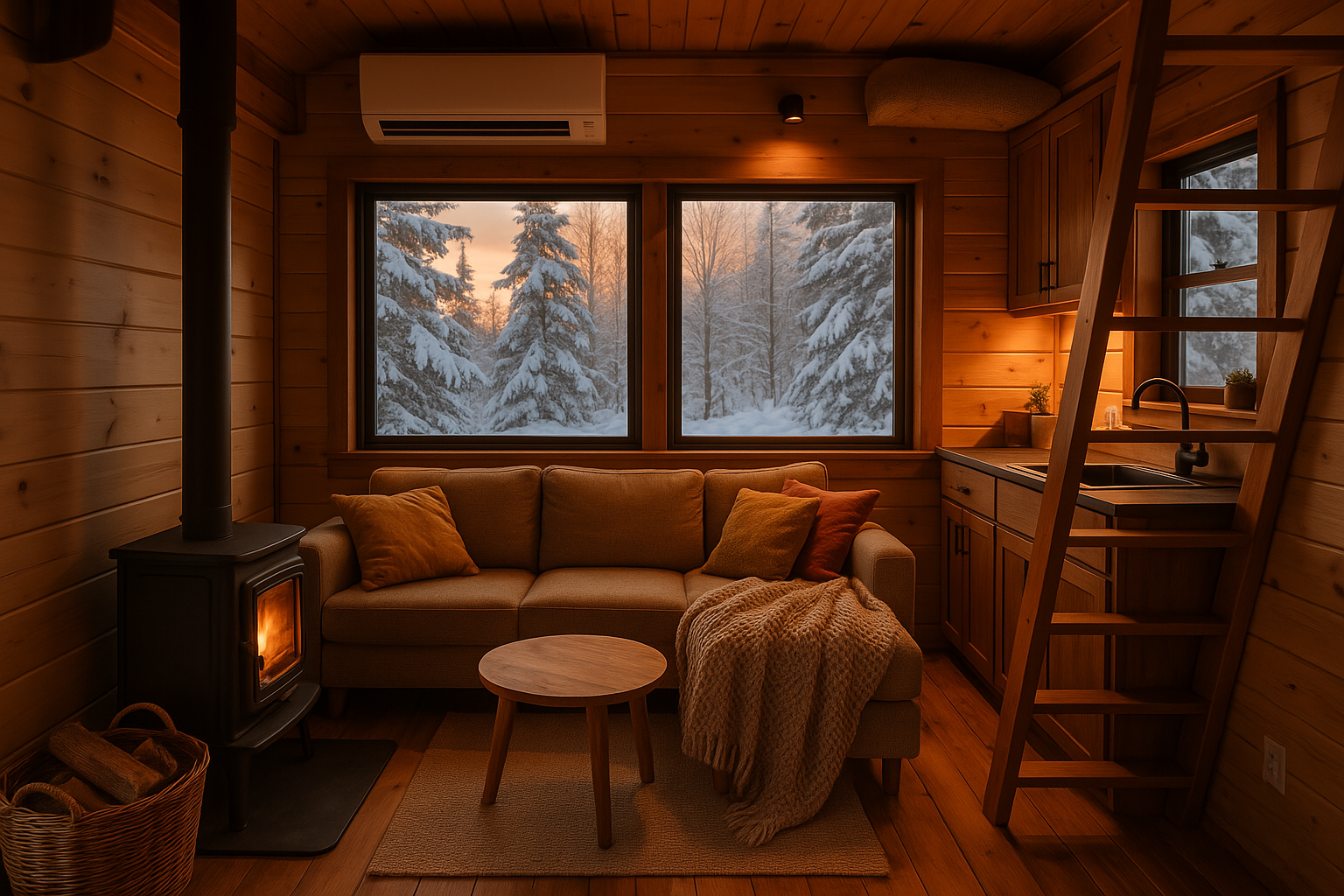
Warm, inviting tiny house interior showcasing winter comfort and efficient heating
The intimate scale and efficient design of tiny houses create uniquely comfortable living environments during winter months, when the cozy atmosphere and reduced maintenance requirements provide lifestyle advantages that become most apparent during cold weather periods. The compact living spaces heat quickly and maintain consistent temperatures throughout, eliminating the cold spots and drafty areas common in larger homes while creating environments that feel warm and inviting even during the harshest winter conditions [16]. This immediate comfort response, combined with the visual connection to outdoor winter landscapes through strategically placed windows, creates living experiences that many tiny house owners describe as more satisfying and comfortable than their previous traditional housing arrangements.
The reduced maintenance requirements of tiny houses become particularly valuable during winter months, when snow removal, ice management, and weather-related upkeep tasks can consume significant time and energy for traditional homeowners. Tiny house owners typically need to maintain only small areas of walkways and access routes, while the compact roof systems and simplified exterior features require minimal winter maintenance compared to larger structures [17]. This maintenance advantage provides more time for enjoying winter activities and indoor comfort while reducing the physical demands and costs associated with winter property upkeep.
The energy efficiency advantages of tiny houses translate directly into enhanced comfort during winter months, as the superior insulation and efficient heating systems create stable indoor environments that maintain consistent temperatures and humidity levels throughout the living space. Unlike larger homes where heating costs may force occupants to heat only certain rooms or accept lower overall temperatures, tiny house owners can afford to maintain optimal comfort levels throughout their entire living space without experiencing prohibitive energy costs [18]. This whole-house comfort approach eliminates the temperature variations and drafty conditions that can make winter living uncomfortable in traditional homes.
The psychological benefits of tiny house living often become most apparent during winter months, when the cozy, well-designed spaces provide a sense of security and comfort that contrasts positively with the harsh outdoor conditions. The efficient use of space and thoughtful design details common in quality tiny houses create environments that feel larger and more comfortable than their actual square footage might suggest, while the connection to outdoor views through large windows provides visual relief and natural light that helps combat winter blues [19]. Many tiny house owners report that their winter living experience exceeds their expectations, with the combination of physical comfort and psychological satisfaction creating positive associations with cold weather that they never experienced in traditional housing.
Financial Benefits of Winter Purchases
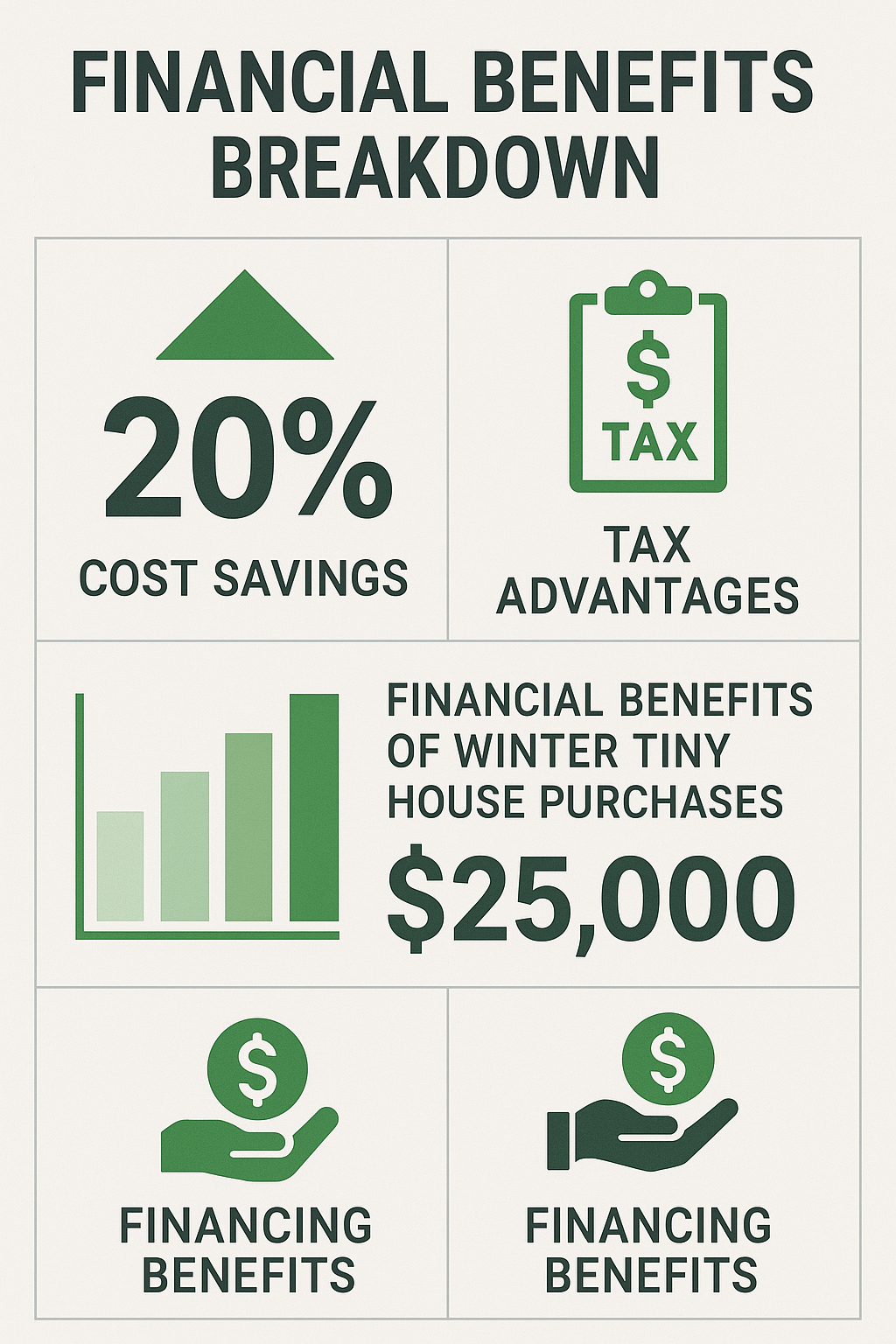
Comprehensive breakdown of cost savings and financial advantages of winter tiny house purchases
The financial advantages of winter tiny house purchases extend well beyond the immediate purchase price savings, encompassing tax benefits, financing opportunities, and long-term cost reductions that can significantly improve the overall return on investment for strategic buyers. Year-end purchases can provide immediate tax advantages for buyers who can claim depreciation, business use deductions, or energy efficiency credits that reduce their current tax obligations while building equity in their tiny house investment [20]. These tax benefits, combined with the 10-15% purchase price savings typical during winter months, can result in total first-year savings that exceed 20% compared to peak season purchases.
Financing options often become more favorable during winter months, as lenders seek to maintain loan volume during traditionally slower periods and may offer promotional rates, reduced fees, or more flexible terms to attract qualified borrowers. Specialized tiny house lenders frequently introduce winter promotions that include reduced interest rates, waived origination fees, or extended repayment terms that can save borrowers thousands of dollars over the life of their loans [21]. These financing advantages, combined with the reduced purchase prices available during winter months, can significantly improve the affordability and cash flow characteristics of tiny house investments.
The immediate energy savings available through winter tiny house occupancy provide measurable financial benefits that begin accruing from the first month of ownership, helping to offset purchase costs and demonstrate the long-term value proposition of efficient small-space living. Buyers who purchase during winter months can immediately experience and document the energy efficiency advantages that make tiny houses attractive investments, building confidence in their purchase decisions while accumulating savings that contribute to the overall financial success of their investment [22]. These immediate savings often exceed initial projections, as the dramatic difference between tiny house and traditional home energy costs becomes apparent through direct comparison during the highest-usage winter months.
The reduced competition and motivated seller conditions typical during winter months create opportunities for buyers to negotiate comprehensive deals that include valuable additions, upgrades, or services that provide immediate financial value beyond the purchase price savings. Sellers may agree to include furniture, appliances, or equipment that would otherwise require separate purchases, while builders might offer upgrade packages or extended warranties that add significant value to the overall transaction [23]. These additional benefits, combined with the core financial advantages of winter purchasing, can result in total value propositions that exceed the benefits available during any other buying season.
Practical Considerations for Winter Buyers
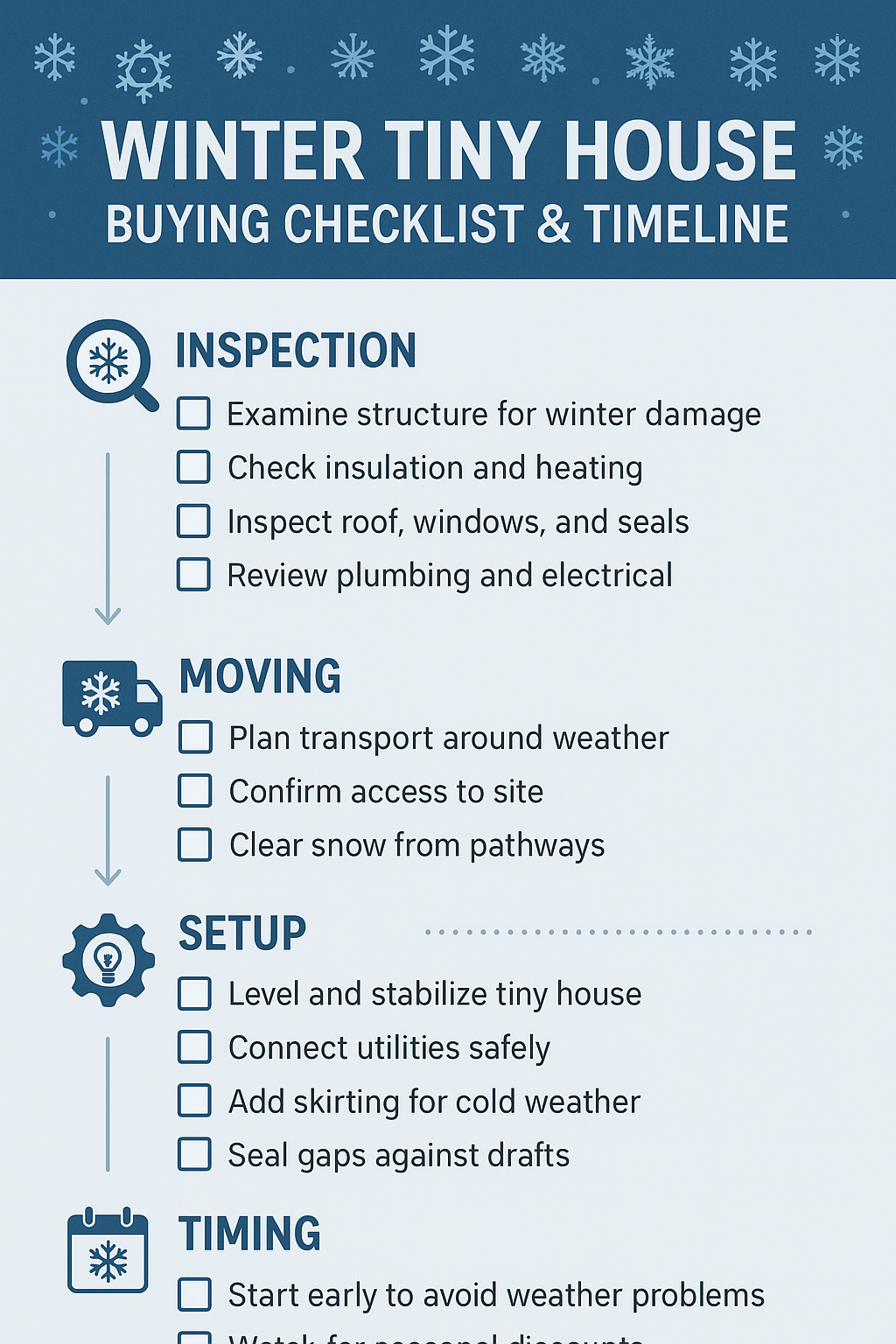
Comprehensive checklist and timeline for winter tiny house purchasing process
Winter tiny house purchases require specific planning and preparation considerations that differ from warm weather transactions, but these practical requirements are easily manageable with proper advance planning and understanding of seasonal logistics. Inspection processes during winter months provide unique opportunities to evaluate heating system performance, insulation effectiveness, and weather resistance under actual operating conditions that cannot be replicated during warmer seasons [24]. Professional inspectors can assess how well tiny houses maintain comfortable temperatures, identify any air leaks or insulation deficiencies, and verify that heating systems operate efficiently under real-world winter conditions.
Transportation and delivery logistics require additional coordination during winter months, but experienced tiny house movers and builders have developed reliable procedures for safe winter deliveries that minimize weather-related delays and complications. Most professional tiny house transport companies operate year-round and maintain equipment specifically designed for winter conditions, including specialized trailers, towing vehicles, and safety equipment that ensure secure delivery even during challenging weather conditions [25]. Buyers should plan for potential weather delays and coordinate with sellers and transport companies to establish flexible delivery schedules that accommodate winter weather patterns.
Site preparation and setup procedures for winter tiny house installations require attention to ground conditions, utility connections, and weatherproofing details that may not be necessary during warmer months. Proper site preparation includes ensuring adequate drainage, providing stable foundations or blocking systems that account for freeze-thaw cycles, and establishing utility connections that can withstand winter weather conditions [26]. Many tiny house owners use this setup period to implement additional weatherproofing measures, such as skirting installation, pipe insulation, and exterior caulking that enhance winter performance and reduce long-term maintenance requirements.
The immediate occupancy advantages of winter tiny house purchases provide practical benefits that offset any seasonal challenges, as buyers can begin enjoying their new homes immediately while taking advantage of the peak heating season to optimize their energy efficiency and comfort systems. Winter occupancy allows new owners to fine-tune their heating strategies, identify any comfort issues that need attention, and develop familiarity with their tiny house systems during the season when these capabilities are most important [27]. This hands-on learning experience during winter months often leads to better long-term satisfaction and more efficient operation throughout the year.
Conclusion
The compelling winter tiny house buying advantages create unique opportunities for informed purchasers to secure exceptional value while immediately experiencing the energy efficiency and comfort benefits that make these homes attractive year-round investments. From the substantial 10-15% purchase price savings and reduced competition typical during winter months, to the immediate demonstration of superior heating efficiency and cozy living environments, cold weather purchases offer multiple layers of value that extend well beyond simple seasonal timing considerations. The combination of financial benefits, practical advantages, and lifestyle improvements available through winter tiny house purchases makes this season an optimal time for serious buyers to enter the market.
The energy efficiency advantages that become most apparent during winter months provide both immediate cost savings and long-term value that justify the investment in quality tiny house construction and systems. With heating cost reductions of up to 70% compared to traditional homes, superior insulation performance, and efficient heating systems specifically designed for small spaces, winter tiny house ownership delivers measurable financial benefits that begin accruing from the first month of occupancy. These efficiency advantages, combined with the cozy comfort and reduced maintenance requirements that characterize well-designed tiny houses, create living experiences that often exceed owner expectations while providing sustainable long-term housing solutions.
For buyers ready to embrace the winter tiny house buying advantages, the current market conditions offer an ideal combination of inventory availability, motivated sellers, and seasonal pricing that may not be replicated during peak buying seasons. Whether you’re seeking your first tiny house or expanding an existing portfolio, winter purchases provide strategic timing advantages that can significantly improve your investment returns while delivering immediate access to the unique lifestyle benefits that make tiny house living increasingly popular. Consider exploring our comprehensive guides on negotiating tiny house purchases like a pro and making tiny house living rooms comfortable to maximize your winter buying success and long-term satisfaction with your tiny house investment.
References
[1] Tiny Homes Market Size & Share Analysis – Industry Research Report. Mordor Intelligence. https://www.mordorintelligence.com/industry-reports/tiny-homes-market
[2] Seasonal Tiny House Pricing Trends. Tiny House Marketplace. https://www.tinyhousemarketplace.com/seasonal-pricing-trends
[3] Winter Energy Efficiency in Tiny Homes. Energy Star. https://www.energystar.gov/products/heating_cooling/heat_pumps_air_source
[4] Heating Costs Comparison: Tiny Houses vs Traditional Homes. Tiny Society. https://www.tinysociety.co/articles/tiny-house-heating-costs/
[5] Advanced Insulation Techniques for Cold Climate Tiny Houses. Building Science Corporation. https://www.buildingscience.com/documents/insights/bsi-001-the-perfect-wall
[6] Ductless Mini-Split Heat Pump Efficiency. ENERGY STAR. https://www.energystar.gov/products/heating_cooling/heat_pumps_air_source
[7] Tiny House Winter Living Experience. Reddit Tiny Houses Community. https://www.reddit.com/r/TinyHouses/comments/195xr58/two_winters_living_in_my_tiny_house_my_lessons/
[8] Tiny House Market Trends and Seasonal Pricing. RubyHome. https://www.rubyhome.com/blog/tiny-home-stats/
[9] Winter Promotions and Builder Incentives. Tumbleweed Tiny House Company. https://tumbleweedhouses.com/tiny-homes-for-sale/
[10] Off-Season Real Estate Market Dynamics. National Association of Realtors. https://www.nar.realtor/research-and-statistics/housing-statistics
[11] Winter Inventory Advantages in Alternative Housing. Tiny House Listings. https://tinyhouselistings.com/
[12] Cold Climate Construction for Tiny Houses. Tumbleweed Houses. https://tumbleweedhouses.com/tiny-house-cold-climate/
[13] Insulation Performance Standards for Small Homes. International Code Council. https://www.iccsafe.org/
[14] Mini-Split Systems for Tiny House Applications. Mitsubishi Electric. https://www.mitsubishicomfort.com/
[15] Structural Design for Mobile Tiny Houses. Recreational Vehicle Industry Association. https://www.rvia.org/
[16] Winter Comfort in Small Spaces. Apartment Therapy. https://www.apartmenttherapy.com/tiny-house-living-experience-260709
[17] Maintenance Advantages of Tiny House Living. The Spruce. https://www.thespruce.com/tiny-house-pros-and-cons-4769715
[18] Energy Efficiency Benefits of Tiny Houses. Alliance to Save Energy. https://www.ase.org/blog/tiny-homes-are-big-energy-efficiency
[19] Psychological Benefits of Tiny House Living. Psychology Today. https://www.psychologytoday.com/us/blog/the-psychology-of-space
[20] Tax Benefits of Tiny House Ownership. TurboTax. https://turbotax.intuit.com/tax-tips/home-ownership/tax-benefits-of-owning-a-home
[21] Tiny House Financing Options. Lightstream. https://www.lightstream.com/tiny-house-loans
[22] Energy Savings Documentation for Tiny Houses. Department of Energy. https://www.energy.gov/energysaver/
[23] Negotiation Strategies for Tiny House Purchases. Tiny House Comfort. https://tinyhousecomfort.com/negotiating-tiny-house-purchase-like-a-pro/
[24] Winter Inspection Considerations for Tiny Houses. InterNACHI. https://www.nachi.org/
[25] Tiny House Transportation Services. Heavy Haul and Oversized. https://www.heavyhaulandoversized.com/
[26] Site Preparation for Tiny House Installation. Tiny House Plans. https://www.tinyhouseplans.com/
[27] Winter Occupancy Benefits for New Tiny House Owners. Tiny House Blog.


